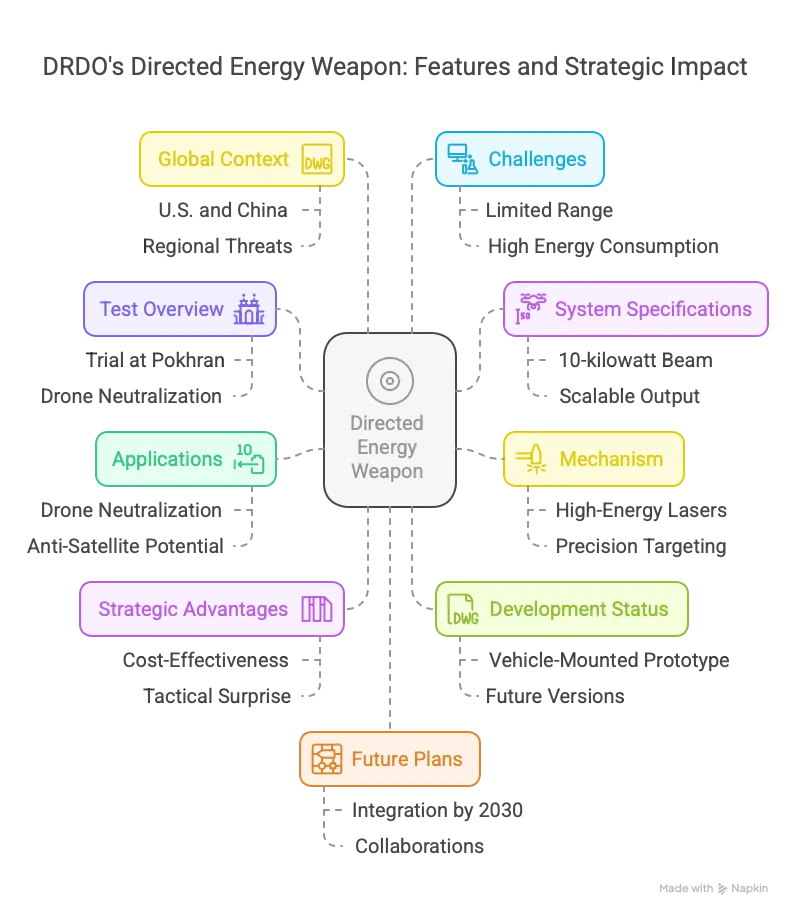UPSC
The Hindu Briefs
DRDO’s Directed Energy Weapon: A Leap in Defence Technology
Last Updated
13th April, 2025
Date Published
13th April, 2025
Share This Post With Someone
 of India.webp?2025-04-13T17:30:02.037Z)
- Test Overview:
- DRDO conducted a successful trial of a laser-based DEW at Pokhran, Rajasthan, on an unspecified date in 2025.
- The system neutralized a drone at 1.5 km range, demonstrating precision and effectiveness.
- System Specifications:
- Generates a 10-kilowatt laser beam, scalable to higher outputs with additional modules.
- Capable of engaging targets like drones, missiles, and unexploded ordnance.
- Mechanism:
- Uses high-energy lasers to burn or disable targets by focusing intense heat.
- Offers pinpoint accuracy, unlike conventional weapons, minimizing collateral damage.
- Applications:
- Neutralizes small aerial threats (drones, balloons) and ground-based explosives.
- Potential for anti-satellite roles and countering hypersonic missiles with upgrades.
- Enhances border security against low-cost threats like drones used for smuggling or attacks.
- Strategic Advantages:
- Cost-effective compared to missile-based defences (laser shot costs ~₹1,000 vs. ₹1 crore for missiles).
- Unlimited “ammunition” as long as power is available, unlike depletable munitions.
- Silent and invisible, providing tactical surprise.
- Development Status:
- Part of DRDO’s ongoing DEW programme, including projects like DURGA-II (100 kW system).
- Current prototype is vehicle-mounted for mobility; future versions may be compact or ship-based.
- Requires advancements in beam control and power efficiency for operational deployment.
- Global Context:
- Joins nations like the U.S., China, and Israel in deploying DEWs for military use.
- Responds to regional threats, e.g., China’s drone incursions and Pakistan’s tactical drones.
- Challenges:
- Limited range in adverse weather (fog, rain) due to beam scattering.
- High energy consumption requires robust power sources.
- Scaling to counter larger threats (jets, missiles) demands technological leaps.
- Future Plans:
- DRDO aims to integrate DEWs into air defence networks by 2030.
- Collaborations with private firms to accelerate production and innovation.
- Potential for export to friendly nations, boosting India’s defence industry.
- Security Implications:
- Strengthens India’s deterrence against asymmetric threats like drone swarms.
- Reduces reliance on imported air defence systems, aligning with Atmanirbhar Bharat.

Key Terms:
- DEW: Directed Energy Weapon, using lasers or microwaves to disable targets.
- Laser: High-energy light beam used for precision targeting in DEWs.
- DRDO: Defence Research and Development Organisation, India’s defence R&D agency.
- Pokhran: Testing range in Rajasthan for India’s defence experiments.
- Drone: Unmanned aerial vehicle, a primary target for DEWs.
- Atmanirbhar Bharat: India’s self-reliance initiative, including in defence production.
- DURGA-II: DRDO’s advanced DEW project for high-power applications.
Link To The Original Article – https://www.thehindu.com/news/national/drdo-tests-directed-energy-weapon-system-that-can-disable-drones-missiles/article69446266.ece?